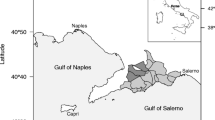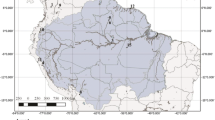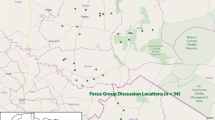Abstract
The lack of scientific rigour in analysing ethnobotanical surveys has prompted researchers to investigate ways of quantitatively describing their data, including the use of ecological diversity indices. There are numerous indices and measures available to describe sample diversity. Twenty-two measures of species richness, diversity and evenness were reviewed using six sets of ethnomedicinal data derived from 50 formal muti shop traders (of different ethnicities) and 100 informal street traders of traditional medicine in Johannesburg, South Africa, and a seventh data set from traders on the western boundary of the Kruger National Park, South Africa. The diversity measures were coupled with species accumulation curves to construct cumulative diversity curves used to determine the minimum viable sample size on which a diversity index should be based, and to better understand the differences in the relative diversities of the samples. Distinct differences in the relative abundance and diversity of plants sold by street traders and shop traders were evident. Species diversity and evenness was found to be higher in shops, thus resulting in a lower dominance in the sale of certain plant species compared to the street traders. A survey of an informal market should include no less than 35 research participants compared to no less than 20 for the muti shops. The use of selected indices of species richness (Margalef's), diversity (Shannon, Simpson's, Fisher's alpha, Hill's numbers) and evenness are recommended as a means of describing patterns exhibited within ethnobotanical data.
Similar content being viewed by others
References
A. Begossi (1996) ArticleTitleUse of ecological methods in ethnobotany Econ. Bot. 50 280–289
J. Botha (2001) Perceptions of Availability and Values of Medicinal Plants Traded on the Western Boundary of the Kruger National Park, South Africa University of the Witwatersrand Johannesburg
J. Botha E.T.F. Witkowski C.M. Shackleton (2001) ArticleTitleAn inventory of medicinal plants traded on the western boundary of the Kruger National Park, South Africa Koedoe 44 IssueID2 7–46
J.E. Brower J.H. Zar (1977) Field and Laboratory Methods for General Ecology Wm. C. Brown Publishers DubuqueIowa
Colwell R.K. and Coddington J.A. 1995. Estimating terrestrial biodiversity through extrapolation. In: Hawksworth D.L. (ed.), Biodiversity Measurement and Estimation. Chapman and Hall, pp. 101–118.
Colwell R.K. 2001. EstimateS: Statistical estimation of species richness and shared species from samples. Version 6, User’s guide and application published at: http://viceroy.eeb.uconn.edu/ estimates.
Cunningham A.B. 2001. Applied ethnobotany: peoplewild plant use and conservation. People and Plants Conservation Manual, Earthscan.
R.P.A. Dauskardt (1990) ArticleTitleThe changing geography of traditional medicine: urban herbalism on the WitwatersrandJohannesburg GeoJournal 22 IssueID3 275–283 Occurrence Handle10.1007/BF00711339
R.P.A. Dauskardt (1991) `Urban herbalism’: the restructuring of informal survival in Johannesburg E. Preston-Whyte C. Rogerson (Eds) South Africa's Informal Economy Oxford University Press Cape Town 87–100
N.J. Gotelli R.K. Colwell (2001) ArticleTitleQuantifying biodiversity: procedures and pitfalls in the measurement and comparison of species richness Ecol. Lett. 4 379–391 Occurrence Handle10.1046/j.1461-0248.2001.00230.x
N. Hanazaki J.Y. Tamashiro H.F. Leitão-Filho A. Begossi (2000) ArticleTitleDiversity of plant use in two Caiçara communities from the Atlantic Forest coastBrazil Biodivers. Conserv. 9 597–615 Occurrence Handle10.1023/A:1008920301824
L.C. Hayek M.A. Buzas (1997) Surveying Natural Populations Columbia University Press New York
Höft M., Barik S.K. and Lykke A.M. 1999. Quantitative ethnobotany: applications of multivariate and statistical analysis in ethnobotany. People and Plants working paper 6. UNESCO, Paris.
M.O. Hill (1973) ArticleTitleDiversity and evenness: a unifying notation and its consequences Ecology 54 IssueID2 427–432
T. Johns E.B. Mhoro P. Sanaya E.K. Kimanani (1994) ArticleTitleHerbal remedies of the Batemi of Ngorongoro DistrictTanzania: a quantitative appraisal Econ. Bot. 48 90–95
C.J. Krebs (1989) Ecological Methodology Harper and Row Publications New York
T.K. Lowrey S. Wright (Eds) (1987) The Flora of the WitwatersrandVolume I, The Monocotyledonae Wits University Press Johannesburg
J.A. Ludwig J.F. Reynolds (1988) Statistical Ecology – a Primer on Methods and Computing John Wiley and Sons Toronto
E.J. Luoga E.T.F. Witkowski K. Balkwill (2000) ArticleTitleSubsistence use of wood products and shifting cultivation within miombo woodland of eastern Tanzaniawith some notes on commercial uses S. Afr. J. Bot. 66 IssueID1 72–85
A. Magurran (1988) Ecological Diversity and its Measurement Princeton University Press Princeton
K.S. Murali U. Shankar R.U. Shaanker K.N. Ganeshaiah K.S. Bawa (1996) ArticleTitleExtraction of non-timber forest products in the forests of Biligiri Rangan Hills, India. 2. Impact of NTFP extraction on regeneration, population structureand species composition Econ. Bot. 50 IssueID3 252–269
O. Phillips A.H. Gentry (1993a) ArticleTitleThe useful plants of TambopataPeru: I. Statistical hypotheses tests with a new quantitative technique Econ. Bot. 47 15–32
O. Phillips A.H. Gentry (1993b) ArticleTitleThe useful plants of TambopataPeru: II. Additional hypothesis testing in quantitative ethnobotany Econ. Bot. 47 33–43
E.C. Pielou (1975) Ecological Diversity John Wiley and Sons New York
G.T. Prance W. Balée B.M. Boom R.L. Carneiro (1987) ArticleTitleQuantitative ethnobotany and the case for conservation in Amazonia Conserv. Biol. 1 296–310 Occurrence Handle10.1111/j.1523-1739.1987.tb00050.x
V.L. Williams K. Balkwill E.T.F. Witkowski (1997) ArticleTitleMuthi traders on the WitwatersrandSouth Africa – an urban mosaic S. Afr. J. Bot. 63 IssueID6 378–381
V.L. Williams K. Balkwill E.T.F. Witkowski (2000) ArticleTitleUnravelling the commercial market for medicinal plants and plant parts on the WitwatersrandSouth Africa Econ. Bot. 54 IssueID3 310–327
V.L. Williams K. Balkwill E.T.F. Witkowski (2001) ArticleTitleA lexicon of plants traded in the Witwatersrand umuthi shops, South Africa Bothalia 31 IssueID1 71–98
Williams V.L. 1992. An investigation of the herbal medicine or ‘muti’ trade on Witwatersrand. BSc (Hons) Dissertation, Department of Geography and Environmental Sciences, University of the WitwatersrandJohannesburg.
V.L. Williams (2003) Hawkers of health: an investigation of the Faraday Street traditional medicine market in Johannesburg, Gauteng DACEL Johannesburg
J. Wong K. Thornber N. Baker (2001) Resource assessment of non-wood forest products: experience and biometric principles FAO Rome
J.H. Zar (1984) Biostatistical Analysis Prentice-Hall, Inc. Englewood Cliffs
Author information
Authors and Affiliations
Corresponding author
Rights and permissions
About this article
Cite this article
Williams, V.L., Witkowski, E. .F. & Balkwill, K. Application of Diversity Indices to Appraise Plant Availability in the Traditional Medicinal Markets of Johannesburg, South Africa. Biodivers Conserv 14, 2971–3001 (2005). https://doi.org/10.1007/s10531-004-0256-4
Received:
Accepted:
Issue Date:
DOI: https://doi.org/10.1007/s10531-004-0256-4




